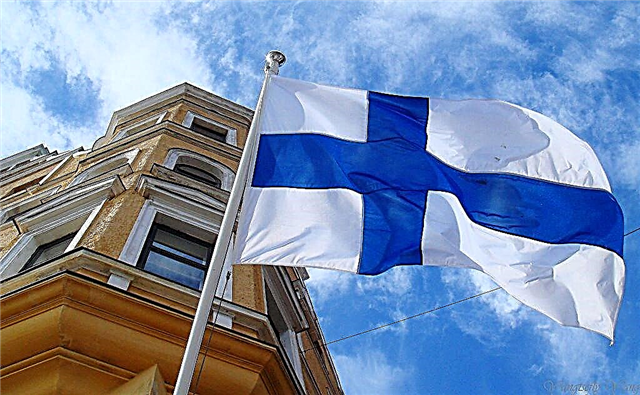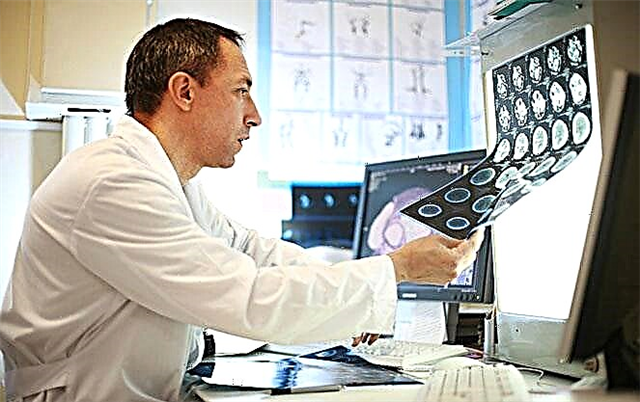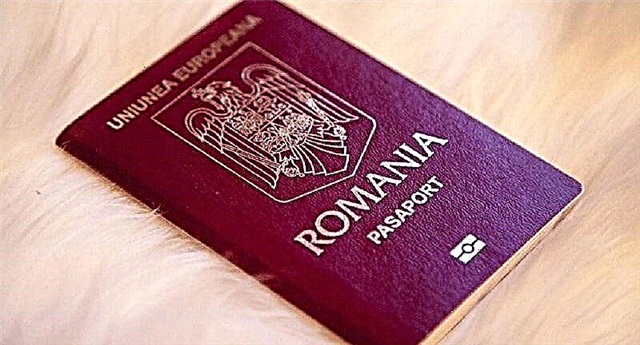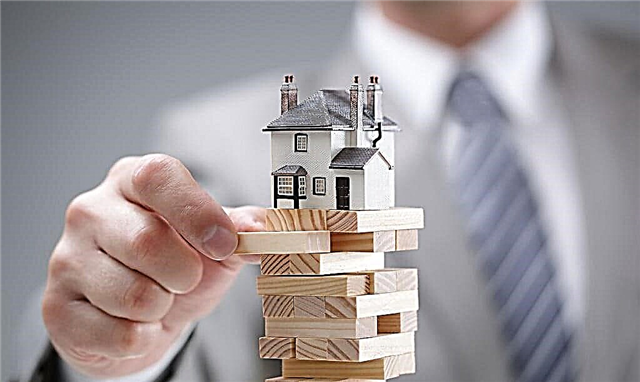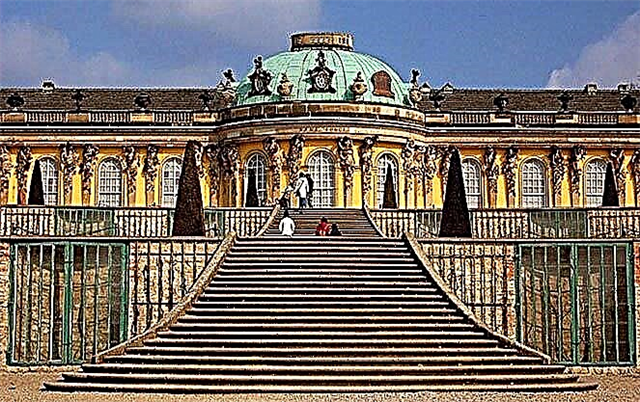The most famous and luxurious landmark in Germany is the Sanssouci Palace in Potsdam. This pearl of the eponymous palace and park ensemble of the Hohenzollern era attracts many tourists with its unusual appearance and rich surroundings. Sanssouci Palace and Park is a UNESCO World Heritage Site due to the combination of architectural creativity, the unification of different artistic directions and unsurpassed landscape design.

The history of the creation of the palace
The idea of building the palace was put forward by Frederick the Great in 1745, when he saw an extraordinary beauty of the hill, traveling from Berlin to Postdam. According to his plan, in a country house there was to be harmony between man and the surrounding nature.

The king himself created the sketches of the building, and the architect Georg Wenceslaus von Knobelsdorf brought them to life.
Such buildings personified the greatness and power of the ruler, therefore Frederick the Great erected a new castle after each victorious war - the Sanssouci Palace was no exception and was also built in honor of the victory in the Seven Years War.
The house was intended for household needs. In it, the ruler spent time himself, studied music, philosophized, recovered strength after battles and arranged social receptions. Women were not allowed into this palace; other places were allocated for them. The grand opening of the palace took place in 1747.
The components of the palace and park ensemble
The grounds of the Sanssouci Palace are carefully thought out. It has everything you need for a comfortable pastime and life. The components of the palace and park ensemble are thought out to the smallest detail and consist of the following structures:
- Friedenskirche ensemble and Marly garden;
- Mausoleum;
- Grotto of Neptune;
- Picture gallery;
- the Sanssouci palace and grape terraces;
- tomb of Frederick the Great;
- New chambers;
- Historic mill;
- the Orangerie Palace;
- Botanical Garden.
- a house with dragons;
- Gazebo;
- New Palace, Colonnaded Arch of Triumph and Commune;
- Antique Temple and Temple of Friendship;
- Charlottenhof park;
- Charlottenhof Palace;
- Roman baths;
- Tea house.
In addition to architectural monuments, beautiful alleys, flower beds and fountains of the park deserve special attention. The most favorable time to visit is in the spring and summer, when the plants are blooming and fragrant. Most of the facilities in Sanssouci Park remain intact, and some have been modernized and improved.
External and internal appearance of the Palace of Sanssouci
The castle is the main building of the park territory. It looks elegant and modern despite being built in the 18th century. The palace has an expensive design, harmonious forms and thought out to the details. The decoration was carried out with the best materials - marble, gilding, fabrics, works of outstanding sculptors and artists.
The restructuring did not spoil the palace - on the contrary, many aspects were improved according to modern parameters. It combines a complex of artistic trends in urban and court European architecture.

Since the palace was not the main one and served as a private residence, its size is small. The main building has one floor with a spacious terrace. Most of the castle doors are glass, which provides good lighting inside.
The main building is in the center of the complex and is surrounded by an art gallery on the right and the New Chambers on the left.
The facade that overlooks the vineyard is decorated with sculptural images with magnificent forms. There are vases on the roof. The southern side of the palace is more colorfully decorated in contrast to the northern one.
An important place in the palace is given to the vestibule (north side) and the marble hall (south side). In the western part there are five guest rooms. On the east side are the royal apartments, which include an audience hall, a concert hall, a bedroom, an office, a library and a long gallery.
The lobby is decorated with Corinthian columns. On the ceiling are picturesque images of the goddess Flora. The floor is made of high quality marble. Throughout the castle, the Rococo style is clearly traced, the luxury of which is visible even in the smallest details.
Greenhouse palace
This is an outstanding architectural monument, which is located near the northern border of Sanssouci Park and stands out from the rest of the buildings. The greenhouse palace was built according to the sketches of the king in 1851-1854 and has survived to this day. The building traces the style of the Italian Renaissance.

In the premises of the palace there is an art gallery with works of famous artists and a museum. In the cold season, exotic plants winter in the halls of the palace.
Picture gallery
The Picture Gallery is one of the oldest museums in Germany. Here are collected the best works of world famous artists: Titian, Nicola Lancre, Jean-Baptiste Pater, Antoine Watteau. The king personally bought the works of Anthony Van Dyck, Caravaggio, Peter Paul Rubens. Friedrich was a true connoisseur of painting, preferring Italian and Dutch art.

The luxurious interior of the gallery pleases every tourist. Marble is laid on the floor to match the ornamented ceiling. There are many paintings on the walls, the gilded frames of which fit snugly together. However, not all of the canvases have survived to this day: most of them were lost during the war.
Chinese tea house
This is a decoration of a summer residence, a garden pavilion in the park of the palace, made in the Chinese style with rococo elements. East Asian building forms adorn the building on all sides, and the roof resembles a marquee. Outside the lodge, there are many gilded sculptures and figures created by Benkert and Heimüller.

Inside there is a circular room, which is surrounded by three offices with open verandas, where a collection of Chinese and Japanese porcelain is exhibited.
Grape terraces
Vineyards on the southern slopes of the hills in Potsdam were planted even before the construction of the palace. The vine was brought from France, Portugal, Italy.

For convenience and beauty, the vineyards are divided into 132 terraces in the center of the park - the same number of steps leads to the top in the central part of the castle.
Sanssouci Park
The park of unsurpassed beauty deserves special attention - a wonderful addition to the royal palace. The development of its surroundings began after the grape terraces were laid out and the palace was built. The ornamental garden included green lawns, trees and flower beds.
Friedrich was a fan of simplicity and versatility, so 3,000 fruit trees were planted in the garden along with ornamental plants. In addition, oranges, bananas, peaches, melons and other exotic fruits were grown in the greenhouses. In addition to plants, the park was decorated with statues of the goddesses Flora and Pomona.
Through the entire territory of the park, from the obelisk in the east to the New Palace in the west, there is a main alley 2.5 kilometers long, along which you can see rotundas and fountains surrounded by marble sculptures.
From the main alley there are a thousand small paths leading to different parts of the park.

The king invested a lot of money in the creation and maintenance of the park. It needed regular watering to keep it in good condition. The fountain system also required the use of new technologies, but at that time there was a lack of professional knowledge in this area. However, a few years later, the king's ideas were brought to life, and the park shone with grandeur and power.
Today, all the plants in the park are rationally distributed. In addition to vineyards, a cherry orchard and an orchard of exotic fruits have been planted.Plants alternate with statues and plaster figures, which adds an unusual flavor to the exterior.
Tourist information
People come to the Sanssouci Palace all year round. It is open 6 days a week, except Monday. During the warm season, from April to October, the visiting time is from 10.00 to 18.00. Work in the winter is reduced by an hour.
The entrance to the palace costs 12 euros, a reduced ticket - 8 euros. Permission to shoot video and take photos will cost 3 euros.
To visit all the objects of the Sanssouci Park, you should purchase a single ticket for 19 euros or a reduced ticket for 14 euros, which is valid throughout the day and gives access to all attractions of the palace and park.
The new palace operates on a different schedule and is available to visit on all days except Tuesday. Working hours - from 10.00 to 18.00. Sightseeing tours take place at 10.00, 12.00, 14.00 and 16.00.
Some of the complex's components - the palace kitchen, the Historic Mill, the Chinese House, the conservatory and the art gallery - have a seasonal schedule with Monday weekends. Their doors are open from 10.00 to 18.00.
On weekends and holidays, park facilities such as the Norman Tower, the Women's Wing and the Belvedere are available to visit. On Tuesdays, guided tours for travelers in groups are held on the territory of the palace, so an independent inspection of the palace and the territory can be done from Wednesday to Sunday.
Sassouci Palace Address
The Sanssouci palace and park complex is located at Potsdam, Maulbeerallee, 14469, Schloss Sanssouci. Official website: spsg.de.
Conclusion
The Sanssouci complex will appeal to connoisseurs of medieval art, historical monuments and beautiful nature. No person will remain indifferent to such a combination of greatness and simplicity. Every element of the palace and garden is striking in its unsurpassed beauty.
To get around and explore the entire territory, one day is not enough. Having visited here at least once, there is a pleasant aftertaste, positive emotions and delight - any tourist will certainly want to return. A trip to the complex is an opportunity to touch the culture and history, a chance to witness the greatness of the Prussian kings.





